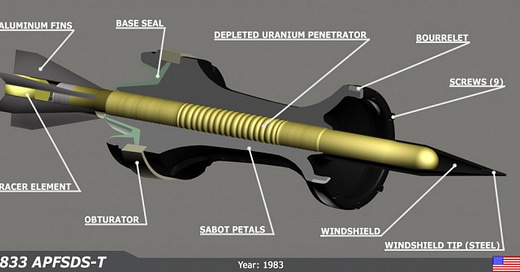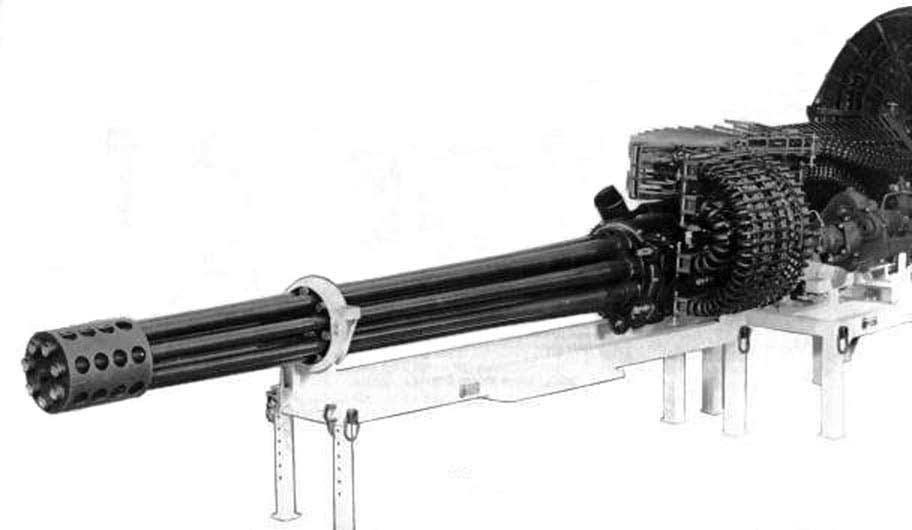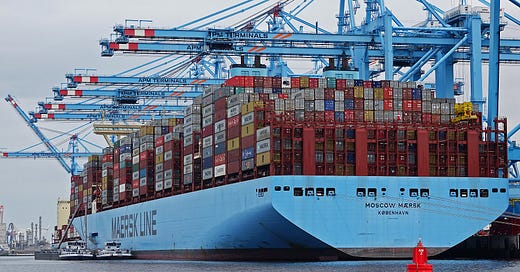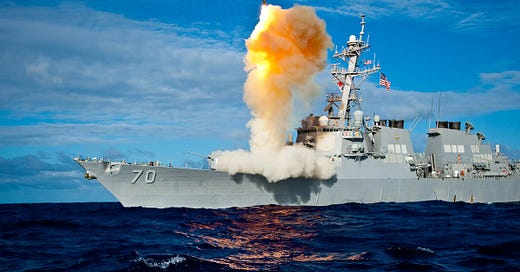

Discover more from Weapons and Strategy
The British announcement that it will be supplying depleted uranium (DU) ammunition to Ukraine for its Challenger 2 tanks is not a one-off. It was arranged with the United States and for good reason. The US has found a way to speed up delivery of Abrams M-1 tanks to Russia, by using older models. The Abrams 120mm smoothbore gun, like the Challenger’s, uses depleted uranium ammunition when it fires armor piercing rounds. Abrams tanks sent to Ukraine will be armed with depleted ammunition “tank busting” rounds.
The ammunition in question is technically called armor-piercing fin-stabilized discarding sabot (APFSDS), long dart penetrator ammunition. APFSDS uses a special penetrating rod made of DU with the addition of titanium and molybdenum. It is highly valued by the military because the DU penetrator is self-sharpening (meaning it does not deform) and pyrophoric. It is highly effective against enemy tanks struck on the side, rear or top, but less so frontally where it can be deflected by sloped armor.
APFSDS penetrators can be made out of materials other than DU, such as titanium.
The Russians call DU ammunition “dirty” weapons.
Depleted uranium is a very heavy, dense metal that is made from uranium hexafluoride. Uranium hexafluoride is the gaseous feedstock for centrifuges making weapon’s grade fissile U-235 for nuclear weapons. Those who promote the use of DU in weapons argue that DU weapons actually contain less fissile material than natural uranium (but not much less). However, they fail to account for the fact that DU is used in a highly compact form, generally to help penetrate armor and other hardened structures. While field studies are inconclusive, opponents of DU say that DU metal fragments in the soil, and DU dust in the air can cause numerous health problems, including cancer. Even naturally occurring uranium is a toxic material. One scientific study says “The aerosol produced during impact and combustion of depleted uranium munitions can potentially contaminate wide areas around the impact sites or can be inhaled by civilians and military personnel.” There is some evidence that DU ammunition played a role in so-called Gulf War syndrome, and also impacts bone marrow density in soldiers hit by DU fragments.
The US is the world’s heavyweight champion in using DU ammunition in Iraq, Syria, Afghanistan, Bosnia and Kosovo. 782,414 DU rounds were fired during the 1991 war in Iraq. More than 300,000 DU rounds were fired during the 2003 Iraq war, the vast majority by US troops.
Both the US and UK have rejected calls to ban depleted uranium weapons.
Aside from armor penetrating tank rounds, the US uses DU ammunition for its 30mm GAU-8 Avenger Gatling gun on the A-10 Warthog ground attack jet fighter. The A-10s figured prominently in the Iraq wars and in Afghanistan. Ukraine last winter requested 100 A-10 jets from the United States and have been secretly training to use the aircraft in combat. If a Crimea offensive takes place, the A-10 may be moved into Ukraine and flown by a combination of Ukrainian pilots and possibly by volunteer former USAF pilots.
The US Air Force has been trying to get rid of the A-10 for some time, considering the craft a relic of the cold war, unlikely to survive in a dense air defense environment. In the latest development, the Air Force said it wants to dump all its A-10s as soon as possible. From a USAF perspective, shifting them to Ukraine relieves them of an unwanted burden.
The US is also seeking to offset Russia’s advantage in artillery by shipping in new 155mm howitzers to replace artillery lost to Russian air and artillery strikes.
The Ukrainian army is currently fighting battles in Bakhmut, Avdiivka, Vuhledar and around Zaporizhzhia. Bakhmut is getting considerable attention because a large number of Ukrainian troops, some elite units, are bottled up there. Estimates say there are as many as 5 Ukrainian brigades involved (perhaps as many as 15,000 soldiers), although these brigades have taken high casualties and some of the troops, but not equipment, have been exfiltrated from the city. Russia’s Wagner forces now claim they control around 70% of the city and have resumed fighting after a brief pause.
The US lost an MQ-9 Reaper drone on March 14, operating only 37 miles from Crimea in a Russian restricted zone. The Reaper is not only a hunter-killer drone, but it has sophisticated sensors that no doubt were being used to gather targeting information, but also to collect ELINT (electronic intercepts) of Russian military units. Caught in the act by two Russian Su-27s, the drone crashed into the sea. Since then, the US has resumed operations, but at a greater distance away from Crimea, using the high-flying RQ-4 Global Hawk, an all-weather, day or night intelligence, surveillance and reconnaissance drone. The Global Hawk uses imagery intelligence (IMINT), signals intelligence (SIGINT) and moving target indicator (MTI) sensors.
The fact that the US was willing to send its drones so close to Crimea suggests that preparations for a Ukrainian-NATO offensive are well underway.
Ukraine is being asked by the US and NATO to launch its offensive against Crimea, starting when sufficient equipment arrives in Ukraine and when the weather is right for a land offensive. Currently Ukraine is getting a lot of rain and the ability to move heavy equipment and armor is restricted to paved roadways as open fields for armor maneuvers are too muddy.
The planned offensive, already telegraphed by US Under Secretary of State Victoria Nuland, will involve a projected 50,000 Ukrainian troops. This is a very large force for Ukraine to commit to a single battle, but the US thinks that Ukraine can win against Russia in Crimea, which Russia regards as strategic, and force Moscow to leave Ukraine. Behind US strategic thinking is that defeating Russia in Crimea would force regime change in Moscow.
The hatred in Washington for Vladimir Putin appears to have no limits. The latest ICC arrest warrant for Putin for alleged war crimes was endorsed by President Joe Biden, and comes as no surprise. That it eliminates any possibility of negotiations between Biden and Putin is the consequence of this rash court action.
How will Russia answer these latest developments? Putin has already sent a warning to Britain about DU ammunition, although what he actually has in mind is not clear. If Russia is watching US activity rushing the Abrams tanks to the battlefield, and the possibility of the A-10, the situation will get more heated.
Russia is also beefing up its already thick air defense belt around Moscow, preparing perhaps for an expanded conflict in Europe.
By introducing DU in Ukraine, NATO increases the risk that the Russian response could be tactical nuclear weapons. NATO, as the Russians see it, is opening the nuclear Pandora’s box. Pandora’s box was described in Hesiod’s 700 BC poem, Works and Days. In the poem, Pandora opening the box would release curses on mankind, including sickness and death.

















Very informative.
It says something about Ukraine's perceived strategic situation that they are happy to have concentrated Uranium dust spread around what they claim is their countryside if it gives them some degree of a tactical advantage.
Ukraine gives another own goal proganda tool to Putin.
Russians standard anti-tank shell for the 125 mm is the Svinets series. To say whether they are using them in Ukraine considering how low they are on ammo is pretty self-evident- of course they are, they'd be stupid not too. And it's not just for the t-80's 125 mm, this works on every 125 mm cannon the Russians have put out since the t-64. The Svinets works on them and has been in service since '91. The 1 and 2 series were newer (1 was tungsten but designed to work with discontinued Black Eagle research tank) and work with the t-90 and any t-72 upgraded to that cannon. The newest set, the "vacuum" the 3bm59, is for the t-14's 125 mm, which also could be on the upgrade cannon list for the older models of tanks. So net net if they have had Uranium based rounds since '91, I think it would be incredibly hard to believe that most of their tank force is not using them as we speak for the original Svinets model and any t90 there would use Svinets-2. I think it's a bit crazy to worry on the health hazards as compared to shelling next to a Nuke plant there too, just as trusting Karzai on any statement is dubious. But hey, that's just me, keep up the reporting Stephen, we read it for a reason.
information on the series of shells and cannon is out there though, not sure if links are appropriate but
https://en.wikipedia.org/wiki/125_mm_smoothbore_ammunition
https://en.wikipedia.org/wiki/2A46_125_mm_gun
You will also find China will probably capitalize on the series too, they are users of the 2a46 model cannon.